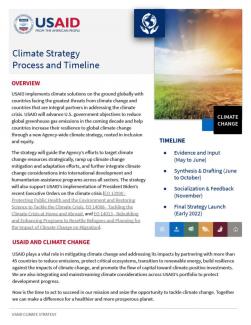USAID will advance U.S. government objectives to reduce global greenhouse gas emissions in the coming decade and help countries increase their resilience to global climate change through a new Agency-wide climate strategy, rooted in inclusion and equity.
USAID implements climate solutions on the ground globally with countries facing the greatest threats from climate change and countries that are integral partners in addressing the climate crisis.
Timeline
- Evidence and Input (May to June)
- Synthesis & Drafting (June to October)
- Socialization & Feedback (November)
- Final Strategy Launch (Early 2022)
The strategy will guide the Agency’s efforts to target climate change resources strategically, ramp up climate change mitigation and adaptation efforts, and further integrate climate change considerations into international development and humanitarian assistance programs across all sectors. The strategy will also support USAID’s implementation of President Biden’s recent Executive Orders on the climate crisis EO 13990 - Protecting Public Health and the Environment and Restoring Science to Tackle the Climate Crisis, EO 14008 - Tackling the Climate Crisis at Home and Abroad, and EO 14013 - Rebuilding and Enhancing Programs to Resettle Refugees and Planning for the Impact of Climate Change on Migration).
USAID plays a vital role in mitigating climate change and addressing its impacts by partnering with more than 45 countries to reduce emissions, protect critical ecosystems, transition to renewable energy, build resilience against the impacts of climate change, and promote the flow of capital toward climate-positive investments. We are also integrating and mainstreaming climate considerations across USAID’s portfolio to protect development progress.
Now is the time to act to succeed in our mission and seize the opportunity to tackle climate change. Together we can make a difference for a healthier and more prosperous planet.
Stakeholder Engagement
The process will not be successful without the input from USAID partners and there will be a robust external engagement process during which stakeholders can review and synthesize evidence and provide recommendations.
Leadership
USAID’s Bureau for Development, Democracy, and Innovation and Bureau for Resilience and Food Security chair the climate change strategy process in collaboration with all USAID operating units under a Climate Change Leadership Council.
Timeline
Evidence and Input Phase (May to June 2021)
During the concept phase, USAID will agree on the priorities and scope of the climate strategy. This includes a review of the evidence and learning from current and past climate change programming and consultations with a wide range of stakeholders, both within the U.S. government and in the external partner community. At the end of this phase, USAID will review and synthesize the evidence and recommendations surfaced through the consultation process and then set priorities to guide the scope of the strategy.
Synthesis and Drafting Phase (June to October 2021)
The Strategy working group and drafting team will spend approximately two months preparing a strategic framework and the first draft of the climate strategy.
Socialization and Feedback (November 2021)
The draft strategy will be released for public comment during this stage and there will be additional opportunities for stakeholders to provide input and feedback.
Strategy Launch (Early 2022)
We expect to release the final strategy in early 2022.
For more information, please contact climatestrategy@usaid.gov.

